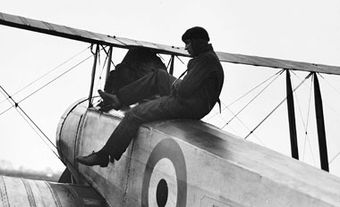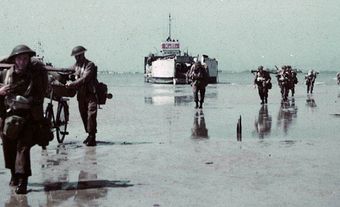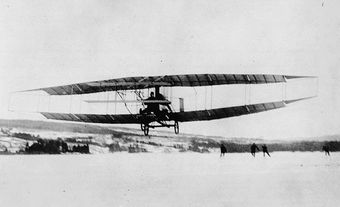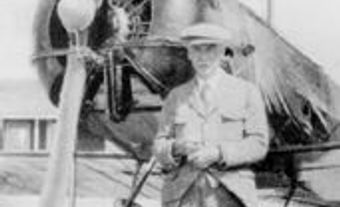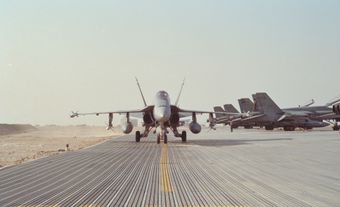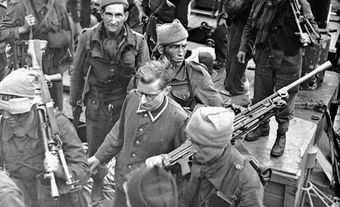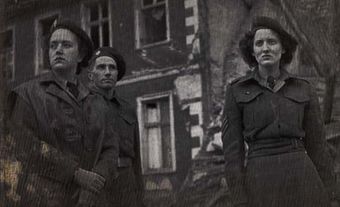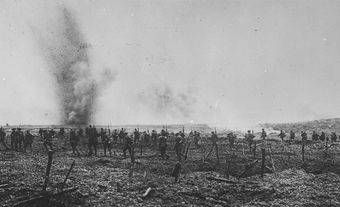Adélard Raymond, pilot, businessman and politician (born 10 July 1889 in Saint-Stanislas-de-Kostka, QC; died 23 February 1962 in Montreal, QC). Raymond was a French-Canadian pilot who served in the First World War and then in the Royal Canadian Air Force (RCAF) from 1934 to 1945. He was the second French Canadian to be appointed air vice-marshal. Raymond was also involved in the hotel industry and in various commercial operations. He was elected mayor of Senneville, on the west island of Montreal, serving from June 1951 to June 1959.

Early Life and Education
Raymond was the third son of Adélard Raymond and Priscilla Quesnel. He had four brothers and three sisters. After completing his education at Valleyfield College, Raymond moved to New York City. There, he became the assistant steward at the City Club for several years. By January 1916, he was the chief steward at the Queen’s Hotel in Montreal, owned by his brother, Donat.
Early Flying Career
In September 1917, Raymond enlisted in the Royal Flying Corps. He conducted his training in Canada and was in the United Kingdom in September 1918. He never served with an operational squadron and was discharged in April 1919. (See First World War.)
Raymond was soon flying in the Montreal area. In 1919 he was appointed as the official aerial photographer for the visit of the Prince of Wales (later King Edward VIII) to Montreal. (See French Canada and the Monarchy.) He also supported the Kiwanis Club and flew in air races, including winning the first Aerial League of Canada Challenge Cup.
On 18 February 1920, Raymond was given a provisional commission as a pilot officer in the Canadian Air Force (CAF). He did not, however, have any further connection to the CAF at the time or participate in training activities. On 12 May, Raymond received commercial pilot license number 27. With Lieutenant Harry Wilshire, a former instructor with the Royal Flying Corps-Canada he formed R and W Air Service. They operated three wartime Curtiss JN-4 “Canuck” from Cartierville Airport on the Island of Montreal. In 1921, R and W Air Service merged with Canadian Aerial Services. Raymond maintained his link with aviation in Montreal, serving as vice-president of the Montreal Light Aeroplane Club from November 1933 to November 1936.
While flying, Raymond was managing director of the Queen’s Hotel, becoming its vice-president in 1931. In this capacity he was involved in the Montreal Hoteliers Association and became its president in 1928. He also served on the board of directors of the Tourist Board of Montreal. As manager of the Queen's Hotel, he was able to use his venue to serve these organizations, as well as others that promoted Montreal.

Raymond served on the board of the Montreal Hunt Club, helping organize various events. He was a member and president of the Laval-sur-le-Lac Golf Club, voted to executive of the Province of Quebec Golf Association in April 1930 and again in 1931. He supported and was president of the Park Tobogganing Club from 1925 to 1935.
On 5 April 1932 Raymond married Marguerite Lafleur. They had two sons.
Did You Know?
Raymond was an accomplished horseman. He won many trophies for his riding abilities in the jumper class, as did the horses he owned. Even during the Second World War he made time to compete. After the war a Raymond Trophy named after him was awarded to the team of best hunter class jumpers. (See Equestrian Sports.)
RCAF Career
On 1 September 1934, the Royal Canadian Air Force (RCAF) formed No. 18 (Bomber) Squadron as part of the Non-Permanent Active Air Force (air reserve). It was the first French-Canadian squadron in the RCAF. Raymond enlisted immediately and was appointed deputy commanding officer with the rank of flight lieutenant. Despite having his pilot's license, Raymond still had to earn his RCAF wings. This involved upgrading his flying skills in areas such as navigation and formation flying. He qualified for his wings in July 1935.
On 1 September 1939, Raymond was promoted to squadron leader and assumed command of No. 118 Squadron (as 18 Squadron was now designated). He had to mobilize the squadron and on 28 October began to move it to Saint John, New Brunswick. Here the squadron was converted to the Coastal Artillery Co-operation role and incorporated members of No. 117 Squadron (which was now disbanded). Training was the main focus, including working with the Militia's anti-aircraft gunners and coastal batteries.
On 9 June 1940, Squadron Leader Raymond was appointed commanding officer of a special detachment assigned to the French air carrier FS Béarn. The Béarn was to carry American aircraft to France with the RCAF providing personnel to train French airmen and pilots on their operation. The capitulation of France meant the delivery could not be made. The Béarn ended up in Martinique on 27 June. Raymond managed to get his airmen back to Canada but only arrived himself on 19 July. He had helped translate during talks between the French and British authorities in the Caribbean as the British wanted the Béarn’s aircraft.
On 3 September 1940, Squadron Leader Raymond was appointed commanding officer of No. 4 Manning Depot at Quebec City. One of the main purposes of the unit was to provide English language training to French-Canadian recruits. As its first commanding officer, he had to build the facility from scratch and ensure the roles of providing basic training and language training were met. With this came a promotion to wing commander on 1 December 1940.
Raymond was by now a well-known officer. On 8 December 1940, he was appointed an honorary aide-de-camp to the Lieutenant-Governor of Quebec, Major-General Sir Eugene Fiset. He was also appointed an honorary aide-de-camp to the Governor-General, the Earl of Athlone. During the visit of the Duke of Kent to Canada in August-September 1941, Raymond was responsible for arranging and coordinating the visit in Quebec.
Wing Commander Raymond assumed command of No. 5 Manning Depot on 10 November 1941. His first major task was to move it from Valcartier to Lachine. Again, he had to oversee the creation of a new training facility from a set of huts into a major RCAF establishment. The position required a promotion to group captain, which came through in June 1942. From 6 April to 25 November 1943 Raymond was commanding officer of No. 2 Service Flying Training School at Uplands (Ottawa). The school trained single-engine fighter pilots.
In November 1943, Raymond was promoted to air commodore and appointed Air Officer Commanding (AOC) No. 3 Training Command. Here he oversaw the operations of the various schools under his command. When Nos. 1 and 3 Training Commands were amalgamated on 15 January 1945, now Air Vice-Marshal Raymond became AOC No. 1 Air Command from 15 January to 3 July 1945. He had already started to close down British Commonwealth Air Training Program schools while at No. 3 Training Command, which became the primary role of No. 1 Air Command. Raymond’s last day of work was 3 July 1945; he retired on 19 September 1945.

Military Recognition
In October 1944, Raymond was awarded the Air Efficiency medal, awarded to members of the RCAF Auxiliary Active Air Force for ten years’ service. (Only 94 were awarded before it was replaced with the Canadian Forces Decoration in 1952.) On 1 January 1945 he was appointed as a Commander, Order of the British Empire. He was later appointed Chevalier, Légion d'honneur and Croix de guerre avec palme. In 1953 he received the Queen Elizabeth II Coronation Medal. A stained glass window is dedicated to Raymond’s memory at CFB Uplands.
Career in Business and Politics
After the war, Raymond continued as vice-president and then president of the Queen’s Hotel. He served as president his family companies – Raymond Hardware and Raymond Distributing. He also continued to serve as honorary Quebec aide-de-camp to the Governor-General, into the mid-1950s and as aide-de-camp for the lieutenant-governor of Quebec, standing in for him on occasion.
Raymond continued his military connections as a supporter of No. 438 Squadron (his old squadron; No 118 had become renumbered during the war). He attended their dinners and change of command parades. He strongly supported the Air Cadet League (see Cadets), including serving on the board of directors, raising funds for them and hosting visiting air cadets from other nations at his home.
Raymond supported many charities including St. John Ambulance Society, the St. Justine Hospital building fund, and the March of Dimes. He was also president of the Quebec division of the Canadian Mental Health Association.
Raymond was involved in commercial organizations. By August 1951, he was on the board of directors of Canadair, Canadian Aviation Electronics, Crown Trust, and Gleneagles investment. He also served as president or vice president of the Canadian Hunter Saddle and Light Horse Improvement Society, the Montreal Hotel Association and the Montreal Tourist and Convention Bureau, and the Royal Automobile Association of Canada.
Raymond became active in local politics. He ran for mayor of Senneville, on the west island of Montreal, winning by acclamation. He served two terms, from June 1951 to June 1959.
Significance
When the RCAF expanded at the start of the Second World War, it not only needed leaders at the operational level, it also needed capable administrators. Air Vice-Marshal Raymond was one such individual. His experience in the hotel industry in Montreal helped him develop this talent as an administrator.
When Raymond was promoted to air vice-marshal on 5 September 1944, he became the second French Canadian to attain that rank and the first French Canadian in the RCAF Auxiliary. (The first French-Canadian air vice-marshal was a member of the Regular Force, Joseph Lionel Elphege Albert de Niverville.)

 Share on Facebook
Share on Facebook Share on X
Share on X Share by Email
Share by Email Share on Google Classroom
Share on Google Classroom


